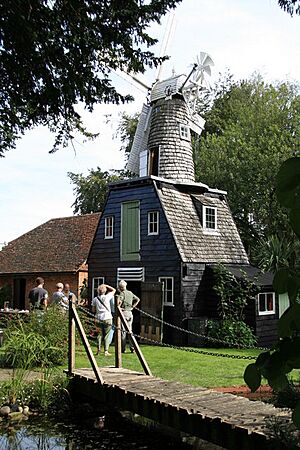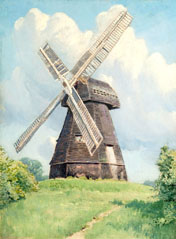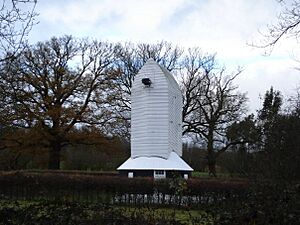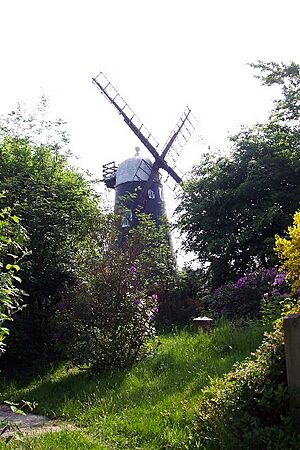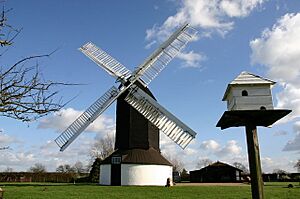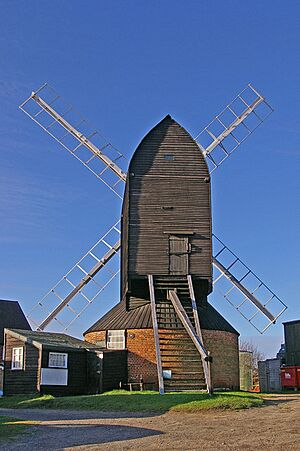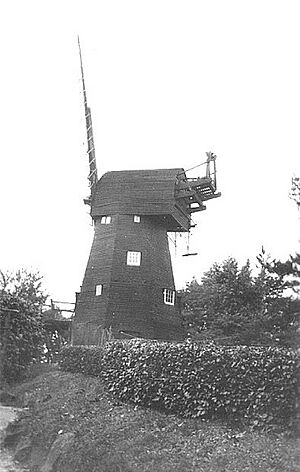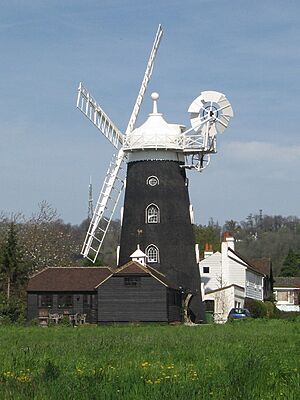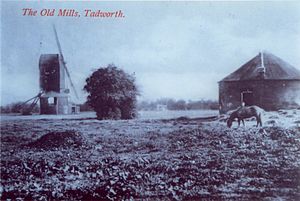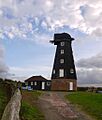List of windmills in Surrey facts for kids
Have you ever seen a giant structure with huge blades spinning in the wind? Those are windmills! For hundreds of years, windmills have been an important part of life in Surrey, a county in England. They used the power of the wind to do many jobs, like grinding grain into flour or pumping water.
This article explores the history of windmills in Surrey. You'll learn about different types of windmills and discover some of the most interesting ones that once stood or still stand in the area.
Contents
What are Windmills?
Windmills are machines that use the energy of the wind. They have large blades, called sails, that catch the wind and turn a central shaft. This turning motion can then power other machinery.
Types of Windmills
There are a few main types of windmills you might find in Surrey:
- Post Mill: This is the oldest type. The whole body of the mill, including the machinery, sits on a single central post. The entire mill can be turned to face the wind.
- Smock Mill: These mills have a tall, tower-like base that is wider at the bottom and narrower at the top, looking a bit like a smock (a type of shirt). Only the top part, called the cap, turns to face the wind.
- Tower Mill: Similar to a smock mill, but the base is usually made of brick or stone and is straight-sided. Like smock mills, only the cap turns.
Famous Windmills in Surrey
Surrey has been home to many windmills over the centuries. Some are still standing, while others are just memories. Here are a few notable examples:
Buckland Windmill
The Buckland Windmill is a smock mill. It was built around the 1860s or 1870s. This mill was used as a saw mill, cutting wood. It has been carefully restored between 1995 and 2003, so you can still see it today.
Shiremark Mill, Capel
The Shiremark Mill in Capel was a smock mill. It was built in 1774. Interestingly, it used some timbers from an older mill called Clark's Green Mill. This mill worked until about 1919. Sadly, it burned down in 1970.
Lowfield Heath Windmill
The Lowfield Heath Mill is a post mill. It was moved to its current location in 1989. This mill is a great example of how these old structures can be preserved.
Hurt Wood Mill, Ewhurst
The Hurt Wood Mill in Ewhurst is a tower mill. It was built in 1855. This mill is another one that has been preserved and is still standing.
Frimley Green Windmill
The Frimley Green Mill is a tower mill. It was built in 1784. You can still see this historic mill in Frimley Green.
Outwood Windmill
The Outwood Mill is a very old post mill. It was built way back in 1665! This makes it one of the oldest working windmills in England. It's a fantastic piece of history.
Reigate Heath Windmill
The Reigate Heath Mill is a post mill. It was built in 1753. What makes this mill special is that it has been converted into a chapel! It's a unique example of how old buildings can find new uses.
Trumpet's Hill Mill, Reigate
Trumpet's Hill Mill was a smock mill in Reigate. It was built in the 1760s. This mill worked for a long time but was eventually taken down in 1950.
Wray Common Mill, Reigate
The Wray Common Mill is a tower mill. It was built in 1824. This mill is another important part of Surrey's windmill history.
New Mill, Tadworth
The New Mill in Tadworth is a post mill. It was built in 1780. This mill is a great example of the post mills that were common in the area.
Other Windmill Sites in Surrey
Many other places in Surrey once had windmills. Some were very old, dating back to the 13th or 14th century. While these mills are no longer standing, their locations remind us of how important wind power once was.
- Alfold: A smock mill here was built after 1813 and worked until about 1870. It was taken down around 1913.
- Ash: The Abbot of Chertsey ordered a new windmill to be built here in 1332.
- Banstead: Hundred Acres Mill was a post mill from 1505, taken down around 1877.
- Belmont: The Folly Mill was a smock mill, marked on a map in 1823. It was taken down around 1890.
- Birtley: A mill built in 1834 to pump water for the Wey and Arun Canal. It was taken down in 1853.
- Blackheath: A smock mill designed for generating electricity after 1923. It was out of use by the 1970s.
- Bletchingley: Cox Hill Mill was moved to Ifield, Sussex, around 1870.
- Carshalton: A mill was marked on a map in 1816.
- Caterham: Mills existed here, with one taken down before 1736 and another, a post mill, likely gone by 1838.
- Charlwood: Several mills were here, including two blown down in a storm on January 13, 1703. Another smock mill burned down in 1901.
- Chelsham: Chelsham Mill, a post mill from 1762, burned down around 1840.
- Chiddingfold: A post mill from 1668 was taken down around 1813. A smock mill built in 1813 had its cap blown off around 1874 and was taken down around 1876.
- Chipstead: Mugswell Mill, a post mill built in 1816, worked until about 1895 and was taken down around 1912.
- Cobham: Fairmile Mill was built around 1805 and taken down in the 1850s.
- Cranleigh: A tower mill from 1703 was replaced by a smock mill around 1800. This smock mill was taken down in 1917. Another mill here pumped water for the Wey and Arun Canal.
- Dorking: Popper Mill was mentioned in 1729.
- Epsom Wells: An early mill from the 15th century and a post mill built in 1796 that burned down around 1880.
- Ewell: A tower mill from 1801 was taken down around 1900.
- Fetcham: Cheshire Mill, a tower mill, was mentioned between 1777 and 1804.
- Frimley: An early mill was mentioned in 1537.
- Godstone: Tilburstow Hill Mill, a post mill from 1760, collapsed in 1805. Godstone Green Mill, another post mill, was taken down in the late 1880s.
- Haslemere: Grayswood Hill Mill, a smock mill from 1785, was taken down in 1886.
- Holmwood: A post mill built in 1775 was taken down around 1880.
- Hookwood: Hookwood Mill, a post mill from around 1820, was taken down in 1896.
- Horley: Horley mill, a post mill from 1762, was taken down around 1900.
- Horne: Horne Mill was standing in 1845 but gone by 1851.
- Horsell: A post mill used as a saw mill existed from 1890 to about 1910.
- Kingston upon Thames: Kingston Mill was mentioned between 1700 and 1733.
- Leigh: Shellwood Common Mill, a post mill from 1795, was still standing in 1915 but gone by 1925.
- Limpsfield Chart: A post mill built in 1816 was taken down in 1925.
- Long Ditton: A mill was mentioned in 1762.
- Merstham: A post mill built in 1786 was taken down in 1896.
- Mitcham: Mitcham Common Mill, a post mill from 1806, was taken down in 1906. There was also a horizontal mill here.
- Nutfield: A post mill was mentioned as early as 1296. Botterys Mill, another post mill from 1680, was taken down in 1929.
- Ockley: Emler Mill, a smock mill from 1803, collapsed in 1944. A replica now stands there for residential use.
- Outwood: Outwood High Mill, a smock mill from 1796, collapsed in 1960.
- Reigate: Many mills existed here, including Oatmill (1800), Blackborough Mill (1700, replaced by a later post mill), and several Cockshot Hill Mills, one of which collapsed by 1639.
- Shepperton: Mills were mentioned here as early as the 14th century.
- South Beddington: A smock mill built in 1835 burned down in 1852.
- Sunbury on Thames: Several mills were mentioned here from 1311 onwards, with one burning down around 1705 and a smock mill taken down in the 1900s.
- Tadworth: Several post mills existed here, with one from 1795 taken down in 1890.
- Walton-on-Thames: Mills were present here from the 18th century.
- Warlingham: Succombs Hill, a post mill, was mentioned between 1198 and 1325. Ashby's Mill, a smock mill, burned down on the day it was built in 1865.
- West Horsley: Windmill Hill Mill, a tower mill from 1729, was taken down in 1866.
- Weybridge: Conduit Hill, a tower mill, was mentioned in 1847.
Maps and Records
Historians and researchers learn about old windmills from historical maps and records. Many maps from the 16th to 19th centuries show where windmills were located. These maps include works by famous mapmakers like John Norden, John Speed, and the Ordnance Survey. By studying these old documents, we can piece together the story of Surrey's windmills.
Images for kids


